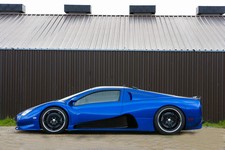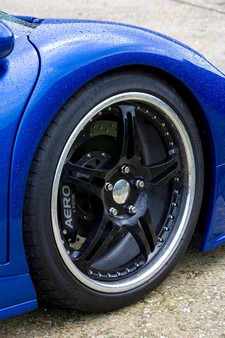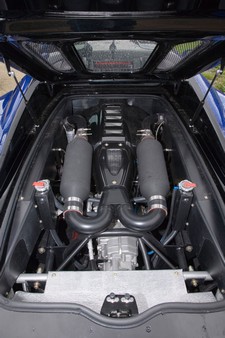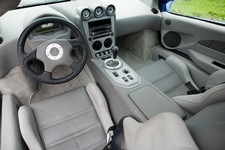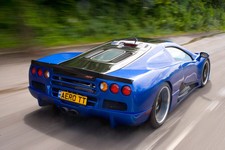SSC Ultimate Aero TT
Tom Stewart gets to grips with nearly 1,200bhp on UK roads

If you want to drive fast, and I mean really seriously fast, you’re spoilt for choice at present – at least in terms of the machinery available, if not the roads to do it on... There’s the 253mph Bugatti Veyron, the 250+mph Koenigsegg CCXR and the Bristol Fighter T with a claimed top speed potential of 270mph, but which will be restricted to 225mph. There’s also the Hennessey Venom Viper with a claimed top speed of 255mph.
Choices, choices, choices… and that’s without considering the SSC Ultimate Aero TT, the world’s most powerful production car, ever. Boasting a truly gargantuan 1,183bhp, the small, little-known Washington State-based company claims a top speed capability of 273mph. In tests earlier this year on a closed section of Nevada highway the SSC managed 230mph in the two miles available, but had the originally intended 12 mile site not been hit by snow, then the Veyron could well have been humbled.
You’ll not be surprised to learn that for my first drive in an Ultimate Aero TT, on UK roads, I had no intention of breaking records, or anything else. But thankfully you don’t have to drive at a third of the speed of sound to get a reasonable idea of what a car’s all about.
With strikingly rich paint, its all carbon composite bodywork looks like something from the mid 1990s. There are echoes of Zonda at the front and Diablo at the sides, while at the rear function has priority over form. There are noticeable variances in some panel gaps, but the giant alloys and big discs (more later) certainly look the part.
There’s little that’s impressive inside as fit, finish and detailing falls far short of the current supercar norm. On the plus side the Aero TT is easy enough to climb in and out of, the leather seats are supportive, it’s reasonably spacious with ample headroom and the driving position is fine apart from the front wheel arch intruding into the footwell,
By now you might be wondering just how the TT’s not insignificant price of $550,000 (ex factory) can be justified, but in the small overhead roof console there’s a large red button, and when you press that this car’s raison d’etre becomes immediately apparent. There’s something akin to a controlled nuclear explosion as the modified, twin-turbo 6,348cc Corvette pushrod V8 bursts into life. This start-up extravaganza only lasts a second or three before the engine settles into a loud offbeat V8 burble, but this is pure, undiluted Yankee muscle.
Despite the Aero TT’s massive torque, moving away sedately from a standstill requires a delicate balance of clutch and throttle. It’s eager either to launch like a dragster, or stall. (I understand this particular car is to soon receive a replacement clutch, which may help.) Despite SSC’s brochure claiming the TT’s rack and pinion steering is assisted, I didn’t feel the slightest hint of assistance. Manoeuvring at parking speeds required strong arms and a firm, two-handed grip on the wheel, but once rolling the SSC is easy enough to drive with a precise gearchange and direct, accurate steering, even by mid-engined supercar standards.
On the road the SSC grips tenaciously. Its nose goes precisely where you point it, when you point it, and the steel tube chassis feels suitably rigid and well-balanced. I can only guess how the car might behave when pushed hard on a track, but with so much power, rear wheel drive and no electronic traction aides, considerable expertise, and prudence, would obviously be required.
Straight-ahead visibility is okay, but the massive A-pillars can be a hindrance. Rear vision is effectively zero, save for the door mirrors and rear-facing camera with pop-out screen in the radio/stereo/satnav unit. The adjustable suspension was set somewhere between firm and rock hard and so the ride was correspondingly unforgiving. Driving one or more of those super-wide Michelins over cats-eyes sent loud staccato bangs and solid thumps directly into the cabin. At legal speeds the exhaust is quiet enough to allow conversation, but lifting off the throttle causes an almighty cacophony from the twin-turbo wastegates.
And then there’s the car’s throttle response, which is like nothing I’ve experienced before. With just the slightest pressure on the pedal the car accelerates briskly. With just a tiny bit more it surges forward with near-terrifying urgency. And all the while there’s a palpable sense of the immense, almost infinite power waiting in reserve. Prod the throttle with anything less than caution and those huge rear Michelins will win gold at the Doughnut Olympics. Fortunately, despite the massive urge available at any speed in almost any gear, the TT can potter along slowly in fifth or even sixth gear without drivetrain snatch.
Although the TT can deliver salt flat-shrinking speed, the brakes on this particular car are something of a mystery. The brochure states that eight-piston calipers should be fitted at the front, but this one had four-piston units. Pedal pressure required even from moderate speeds was inordinately high, with almost no feel or power. (I still await an explanatory response.)
Which leads to the ultimate question concerning the Ultimate Aero TT: who would want one? You could argue that $550k, or about £335k by the time it’s otr in the UK, is ludicrous wedge for a left-hand-drive car with no heritage, a slightly dated appearance, zero luggage capacity, the luxury of a small Malaysian hatchback, iffy build quality and nothing to indicate that it won’t depreciate faster than you could set light to it.
Conversely, it’s more powerful, more exclusive, and potentially faster than a Veyron, while costing less than half as much. And since when did all-American muscle have to dress up like posh European aristocracy? Some loud paint, serious wheels and an even louder V8 is all it really needs, and that’s what it’s got, in unprecedented abundance. Neither argument is wrong, so I guess owners will be few, and just a little keener on driving at almost four times the national speed limit than most of us.
Specification:
- Engine - mid-mounted, all-alloy 16-valve V8 twin turbo
- Displacement - 6,348 cc (387.2 cu in)
- Power - 1,183 bhp (1,199 PS) @ 6,950 rpm (7,200 rpm redline)
- Torque - 1,094 lb/ft (1,484 Nm) @ 6,150 rpm
- Transmission - 6-speed manual, rear wheel drive
- 0-60 mph - 2.78 secs
- Standing 1/4 mile - 9.9 secs @ 144mph
- 60-0mph - 31.4 metres (103 ft)
- Top speed - 273 mph (claimed, see text)
- Chassis - steel tube space frame
- Body - carbon fibre composite, flat undertray with venturi tunnels
- Cd - 0.357
- Brakes - 14 inch vented, cross-drilled discs, 8-piston* calipers (front), 6-piston* (rear), (*see text)
- Suspension - double wishbone (front); upper rocker arm, lower wishbone (rear), remote reservoir, adjustable Penske dampers, coil-over springs, anti-roll bar
- Wheels - forged, 3-piece alloy, 19 x 9.5” (front), 20 x 13” (rear)
- Tyres - Michelin Pilot Sport PS2, 235/35 19 (front), 335/30 20 (rear)
- Price - $550,000 ex factory, approx £335,000 on the road in UK
Pictures: Jim Forrest
Gassing Station | Yank Motors | Top of Page | What's New | My Stuff

